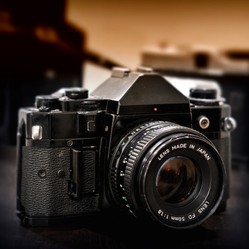What is Photography?
Photography is a technique of recording the image of a certain area at a certain moment in time. It is involves the process of obtaining images upon - sensitized surfaces by the action of light or other radiant energy. The word is derived from the Greek, meaning "to draw with light".
Several operations comprise the photographic process. First, a lens forms an image upon a layer containing light-sensitive chemicals, usually silver salts called halides. The equipment used for this purpose is called a camera.
Prior to the advent of digital cameras, the light-sensitive substance was suspended in a gelatin coating on a transparent material. The transparent material used for this purpose was usually either plastic photographic film or a glass photographic plate.
To produce a photograph, or permanent image, the film or plate was exposed to light reflected from or emanating from the subject. After exposure the film was developed, or treated chemically, to convert the image to permanent form. Developing usually produced a negative, or an image in which light objects appear dark and dark objects appear light. The material used for the negative was a transparent film, or less frequently, a glass plate coated with an emulsion of silver halide suspended in gelatin. After development, the residual, unchanged silver salt is removed by a solution containing thiosulfate (hypo), and the fixed negative was washed and dried.
The negative was used to produce a positive image, called a print or photograph, on light-sensitive paper. Any number of positive prints can be made from the negative by exposing through the negative a light-sensitive surface, such as paper coated with silver chloride suspended in gelatin. The exposed material was then subjected to a chemical treatment similar to that given the negative in order to form the final positive image.
Some photographic films, particularly color films, yielded a positive image through a more complex developing process. The positive images, which have been recorded on transparent film, were known as transparencies or slides.
Exposure of the film or plate was carried out with a camera. The camera was basically a lightproof box equipped with a shutter mechanism to admit light for very short periods of time and a lens to focus the light onto the surface of the film.
Nowadays, due to technological advancement, images are captured by digital camera, negating the need for film processing. Plug and play has been added to point and shoot, making the both professional and amateur photography an even easier task when it comes to viewing and making prints.
Uses of Photography
In general, photographs provide visual records of events, people, objects, and scenery. They can be saved for future reference, used to analyze a momentary event at leisure, and reproduced as a means of communication in books, newspapers, or magazines.
Photographs of people or of objects can be used for identification purposes. Since photography can produce exact copies of written or printed matter, it is widely used in record keeping and in the production of printing plates.
Special photographic techniques permit the recording of objects and events to which the eye is not sensitive. X-ray photography is used in medicine and industry to examine enclosed objects.
Infrared photography, which records heat emission, is important in military reconnaissance, since camouflaged objects emit heat differently from the material they are made to resemble visually. High-speed photographs record instantaneous images of objects moving too rapidly to be seen except as a blur. Photographic plates given long exposures through a telescope register images of distant stars too faint to be seen by the eye through the same telescope.
Photography is also an art form. Through a photograph an artist can present his perception of design, beauty, or drama, often in the most commonplace objects or events.
Artistic photography has adapted many of the principles of painting or drawing to photographic techniques. In turn, many of the techniques evolved by artist-photographers are used in commercial forms of photography, such as advertising and fashion photography.
The artistic aspects of photography are also used, often very well, in the popular hobby of amateur photography.
You might also like
Macro PhotographyEach photographer will have one particular form of photography they enjoy doi...
Creating Bookmarks at ZazzleI am doing a 365flowers RedGage Challenge with a group of folks. We have tak...
Practice Photography in your own Back YardYour own back yard is a great place to practice your photography skills.




 Photographic Styleon 10/14/2011
Photographic Styleon 10/14/2011
 Interchangeable Lenseson 09/28/2011
Interchangeable Lenseson 09/28/2011
 Negative Blisters and Blemisheson 09/17/2011
Negative Blisters and Blemisheson 09/17/2011
 Daguerreotypeon 08/24/2011
Daguerreotypeon 08/24/2011



Comments